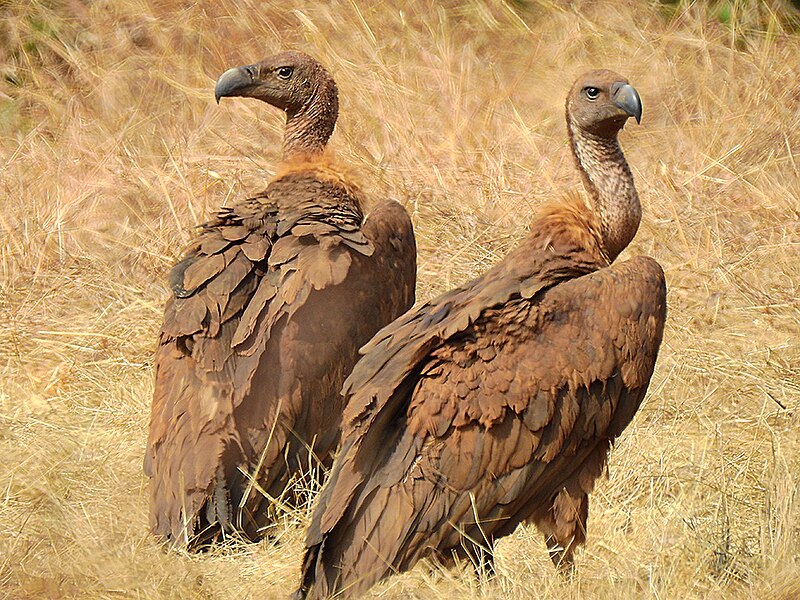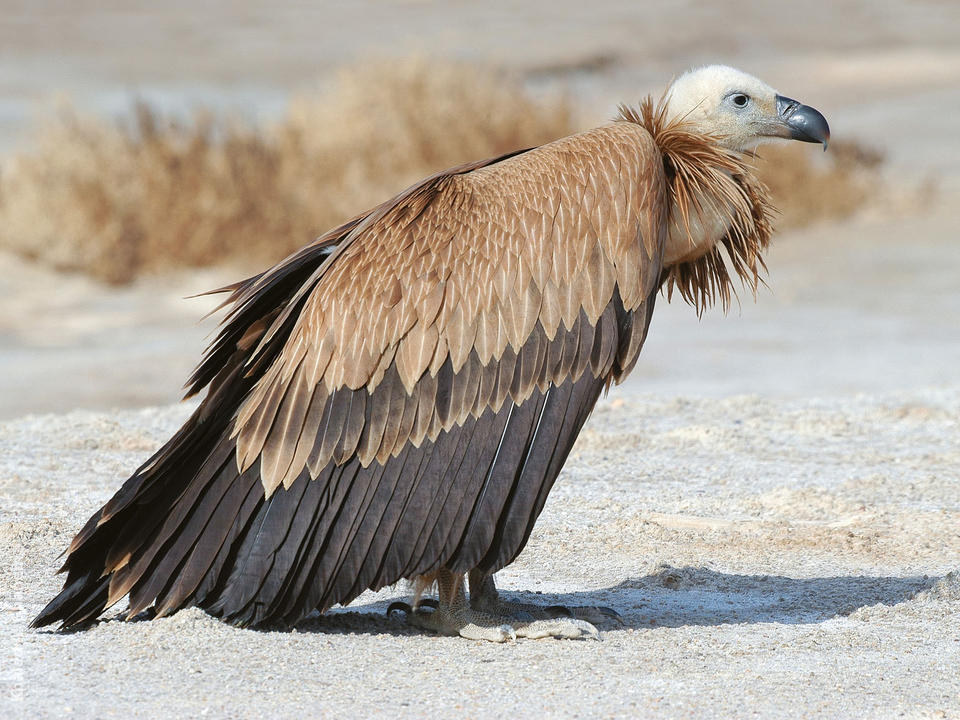White-rumped Vulture Bird Details
Gyps bengalensis
White-rumped Vulture,Bengal Vulture;
Safed Pankh Wala Giddh
Johann Friedrich Gmelin,1788
Accipitriformes (HAWKS, EAGLES and KITES)
Accipitridae
Gyps
India, Nepal, Pakistan, Bangladesh, and Bhutan.
Appearance :
It has a pale head and neck, with the rest of the body covered in white and grey feathers. The most striking feature is its white rump and a dark, bare head.
Behaviour :
It is a scavenger, primarily feeding on carrion. It plays a crucial ecological role by cleaning up dead animals. The White-rumped Vulture soars on thermal updrafts and is known for its soaring flight style. They are monogamous and usually breed in large colonies, building their nests on cliffs or in large trees.
Habitat :
This vulture inhabits open and semi-open landscapes, including grasslands, savannas, and lightly forested areas. It is often found near human settlements due to the availability of carrion.
Diet :
It primarily feeds by scavenging carcasses and plays a critical role in the ecosystem by preventing the spread of disease.
Conservation Status :
Critically Endangered
Distribution :
Historically found throughout the Indian subcontinent, including India, Nepal, Pakistan, Bhutan, and Bangladesh.
Population Size :
Fewer than 10,000 individuals remaining
Life Span :
Live up to 20 years or more.
Body And Tarsus:
- Body: The White-rumped Vulture is a large, robust bird with a predominantly pale plumage. Its body is well-adapted for soaring flight with broad wings and a strong build.
- Tarsus Length: Approximately 10 to 12 cm (4 to 4.7 inches). The tarsus is the part of the leg between the knee and the foot.
Head And Bill :
Head: The head is relatively small compared to the body, with a bare, dark-colored skin.
Bill: The bill is strong and hooked, adapted for tearing flesh from carrion.
Bill Length: Around 5 to 7 cm (2 to 2.8 inches).
Length :
Typically 78 to 93 cm (31 to 37 inches) from beak to tail.
Neck :
The neck is relatively short and strong, with bare skin that helps in reaching carrion efficiently.
Size :
Medium to large raptor; body size varies slightly among individuals.
Tail Details :
- Tail: The tail is broad and slightly wedge-shaped, aiding in balance and maneuverability during flight.
- Tail Length: Approximately 22 to 25 cm (8.7 to 9.8 inches).
Weight :
Ranging from 5 to 7 kg (11 to 15.5 lbs).
Wing :
The wings are broad and slightly tapered with large surface areas to maximize lift and soaring efficiency. They have a broad, rounded appearance with long, pointed primary feathers.
Wing Span :
About 2.2 to 2.7 meters (7.2 to 8.9 feet).
Facial Feature :
The White-rumped Vulture has a distinctively bare head and neck, which are pale in color. The facial features are adapted to its scavenging lifestyle, allowing it to feed efficiently on carrion.
Nest Details :
- Nest: Nests are usually built on large trees or cliff ledges. In some cases, they may use man-made structures or buildings. The nests are large and bulky, often constructed in high, secure locations to protect the eggs and chicks from predators.
- Nest Made Up Of: The nest is constructed from sticks, branches, and other plant materials. It may also incorporate leaves, grass, and sometimes even human refuse. The interior is lined with softer materials like leaves and feathers for comfort.
Breeding Season :
Typically spans from December to April
Nesting Season :
The nesting season coincides with the breeding period.
Egg Color :
The eggs are generally pale blue or white, sometimes with a few speckles or blotches.
Egg Length :
Approximately 8 to 9 cm (3.1 to 3.5 inches).
Egg Width and Weight :
Egg Width: About 6 to 7 cm (2.4 to 2.8 inches).
Egg Weight: Roughly 140 to 200 grams (5 to 7 ounces) per egg.
Clutch Size :
Typically 1 to 2 eggs per clutch.
No. of Broods :
Usually one brood per year.
Incubation Period :
The incubation period lasts about 45 to 50 days
Nestling Period :
The nestling period, lasts about 3 to 4 months.
Vocalization :
The vocalizations are relatively quiet compared to other birds of prey. They produce low, hoarse calls and occasional grunts or hisses.
Sex Demorphism :
Size and weight differences between sexes are not significant.
Migration Details :
Generally, White-rumped Vultures are resident birds, meaning they stay within their breeding and feeding ranges throughout the year. They do not undertake long-distance migrations.








